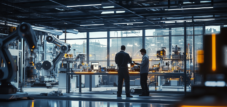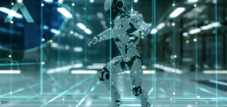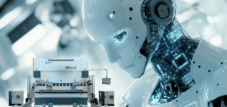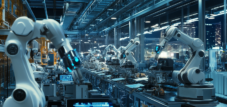“Physical AI” & Industry 5.0 & Robotics – Germany has the best opportunities and prerequisites in physical AI
Xpert pre-release
Language selection 📢
Published on: November 25, 2025 / Updated on: November 25, 2025 – Author: Konrad Wolfenstein

“Physical AI” & Industry 5.0 & Robotics – Germany has the best opportunities and prerequisites in physical AI – Image: Xpert.Digital
Germany has a 24-month window of opportunity – the AI transformation must succeed within this short period.
From generated word to executed deed: Germany's fateful hour in the era of Physical AI
While the world is still marveling at the capabilities of generative language models, the next, far more profound tectonic shift in the technological landscape is already taking place in the background. The era of purely digital algorithms is giving way to the era of "Physical AI"—an embodied artificial intelligence that no longer merely composes texts, but perceives, understands, and actively interacts with the physical world. What initially sounds like science fiction is currently developing into the decisive battleground of global industry, with projected market growth reaching nearly 68 billion US dollars by 2034.
For Germany as an industrial location, this development marks a historic turning point: While we were previously powerless in the pure software race against Silicon Valley, the cards are now being reshuffled. Physical AI requires not only digital intelligence, but also excellent mechatronics, precision mechanical engineering, and deep domain expertise – precisely those virtues that form the backbone of the German economy.
But international competition never sleeps. Between the innovation-driven USA and China, which specializes in mass production, a critical window of opportunity of only about 24 months is opening up for Germany. In this short period, the transformation must succeed: from rigid industrial robots to adaptive, humanoid systems, supported by sovereign computing infrastructures such as the new "Industrial AI Cloud" from Telekom and NVIDIA.
This analysis sheds light on why Germany has a structural “unfair advantage” in the field of physical AI, how visionary players from Munich and Metzingen want to combat the shortage of skilled workers through humanoid robotics, and why the years 2024 to 2026 will decide whether we are reduced to a mere hardware supplier or emerge as the leading market of the next industrial revolution.
Suitable for:
- The clever factory with industrial AI: in addition to robotics of clever sensors to the fully automatic factory
Whoever controls the physical world controls the industrial future
The convergence of artificial intelligence and robotic execution marks a tectonic shift in the global technology landscape. While the past decade was defined by the dominance of digital platforms and generative language models, the coming decade will be characterized by Physical AI, the embodied artificial intelligence that no longer merely generates text but perceives, understands, and acts within the real world. The global market for Physical AI, which was a modest $3.78 billion in 2024, is projected to grow to an estimated $67.91 billion by 2034, representing an eighteen-fold increase. This development is taking place against a backdrop of intense geopolitical competition between the United States, China, and Europe, with Germany potentially playing a key role due to its unique industrial base and mechatronic expertise—a role it never held in the field of pure software AI.
The central thesis of this analysis is that Germany possesses a structural advantage in the field of physical AI that it lacks in the field of generative AI. While Silicon Valley dominates in algorithms and large language models, and China has perfected the mass production of consumer hardware, Germany has decades of accumulated domain expertise in precision mechatronics, mechanical engineering, and industrial manufacturing, as well as access to the world's most valuable industrial data. Whether this opportunity is seized will be decided in a critical window of opportunity between 2024 and 2026, which is currently opening and will soon close again.
Suitable for:
The tectonic shift from learning algorithms to acting machines
The most fundamental shift in the field of physical AI is occurring at the level of foundational models for robots. Traditional industrial robots followed rigid, programmed sequences, an if-then logic that had to be painstakingly implemented by specialized engineers for each new task. This era is coming to an end. Vision-Language-Action models, or VLA models for short, are taking their place. These represent a new class of multimodal foundation models that combine visual perception, language understanding, and physical actions in a single system. Such a model captures a camera image of the robot's environment, processes a textual instruction, and directly outputs low-threshold robot actions that can be executed to complete the task. This happens without the explicit programming of individual movement sequences.
The technical architecture of these systems typically consists of two components: a pre-trained vision-language model, which serves as the perception and reasoning core and encodes camera images along with speech instructions into a common latent representation, and an action decoder, which translates this representation into continuous movements that the robot can execute. The models are trained on datasets containing robotic demonstrations in the form of pairs of visual observation, text instruction, and motion trajectory. These demonstrations can be generated by real robots, via human teleoperation, or synthetically in simulation environments.
The implications of this development are far-reaching. Robots no longer need to be programmed individually for each task, but can be transferred to new tasks through a few demonstrations or natural language instructions. The Helix system, developed for humanoid robots, demonstrates the scalability of this approach and has been trained for approximately 500 hours of robotic teleoperation using automatically generated text descriptions. The decoupled architecture, which separates strategic thinking and task planning in a System 2 module from rapid responsiveness and fine motor precision in a System 1 module, enables both broad generalization and rapid, low-threshold control.
This presents a strategic opportunity for Germany. The precise hardware required for these foundation models to execute perfectly aligns with the strengths of German engineering. Companies like NEURA Robotics from Metzingen and Agile Robots from Munich are developing systems that are no longer optimized for a single action, but can solve tasks generically. The startup GEN-0 has introduced a new class of embodied foundation models trained on a corpus of 270,000 hours of real-world manipulation trajectories and capable of functioning across various robot embodiments, from six-axis and seven-axis systems to semi-humanoid systems with more than 16 degrees of freedom.
The architecture of sovereign computing infrastructure as an industrial foundation
The question of technological sovereignty has transformed from an abstract political concept into a concrete industrial necessity. On November 5, 2025, Deutsche Telekom and NVIDIA unveiled the world's first Industrial AI Cloud in Berlin, a sovereign, enterprise-ready platform scheduled to go live in early 2026. This partnership combines Deutsche Telekom's proven infrastructure and operations with NVIDIA's AI and Omniverse digital twin platforms and represents a one billion euro investment funded entirely by the private sector.
The technical substance of this initiative is remarkable. In a renovated data center in Munich, more than a thousand NVIDIA DGX B200 systems and RTX PRO servers are currently being installed, housing up to 10,000 NVIDIA Blackwell GPUs. This computing capacity increases the AI computing power available in Germany by approximately 50 percent. The platform utilizes state-of-the-art software stacks, including NVIDIA AI Enterprise and NVIDIA Omniverse, which are fully integrated into Deutsche Telekom's cloud and network ecosystem.
The strategic importance lies in the combination of computing power and data sovereignty. Jensen Huang, founder and CEO of NVIDIA, succinctly formulated the vision: Every manufacturing company will own two factories in the future, one for the physical product and one for the AI that enables that product. The Industrial AI Cloud provides leading companies in manufacturing, automotive, robotics, healthcare, energy, and pharmaceuticals with the computing power they need for AI training, simulation, and deployment at scale.
A key element is the so-called Germany Stack, a secure, sovereign digital infrastructure developed jointly by Deutsche Telekom and SAP. Telekom provides the physical infrastructure, while SAP contributes the Business Technology Platform and AI-based applications. This combination guarantees the highest standards of data protection, security, and reliability under European regulations. This is of vital importance to German SMEs with their valuable process secrets, as sensitive design data and manufacturing parameters do not need to be uploaded to foreign servers.
The first customers and partners of this new AI factory have already been announced. Besides SAP and Deutsche Telekom itself, these include Mercedes-Benz and the BMW Group, which will be able to conduct highly complex simulations with AI-supported digital twins and massively accelerate their development processes for new vehicles. Robotics companies such as Agile Robots and Wandelbots have also been named as partners, as have the AI search engine Perplexity and the drone manufacturer Quantum Systems.
The return of the machine-man to the production hall
The humanoid robot, long the subject of science fiction fantasies, is entering industrial reality. The global market for humanoid robots is projected to reach $15 billion by 2030, with an annual growth rate of 39.2 percent, and $51 billion by 2035, with an expected annual growth rate of 55 percent. Goldman Sachs forecasts 50,000 to 100,000 humanoid units shipped worldwide in 2026, while manufacturing costs will fall to $15,000 to $20,000 per unit due to economies of scale. By 2035, annual shipments could reach into the millions.
Germany is positioning itself in this growth market with two promising players. NEURA Robotics, founded in 2019 by David Reger in Metzingen near Stuttgart, has established itself as the world's only company that develops and manufactures intelligent, cognitive robots entirely in-house. In January 2025, the company secured €120 million in Series B funding to accelerate the development of cognitive humanoid robots in Europe for various industries. The 4NE1, a 1.80-meter-tall humanoid robot weighing 80 kilograms with a payload capacity of 15 kilograms, is designed to be Europe's first mass-produced humanoid robot.
The second major German player is Agile Robots, founded in 2018 by Dr. Zhaopeng Chen and other experts from the German Aerospace Center (DLR). The company unveiled its first humanoid robot, the Agile One, in November 2025 and plans to begin series production in early 2026 at a new factory in Fürstenfeldbruck. In 2024, the company generated sales of approximately €200 million and employs more than 2,500 people in Germany, China, and India. The Agile One is specifically designed for use in industrial environments, where it will work safely and efficiently alongside humans as well as other robotic systems.
Agile One's unique technological features include a high-precision robotic hand, which the company claims is the most precise in the world, with five movable fingers, fingertip sensors, and force-torque sensors in the joints. The robot's AI was trained using one of Europe's largest industrial datasets, as well as human-collected data. The architecture is based on a multi-layered AI structure, with each layer specializing in a specific level of cognition and control, from strategic thinking and task planning to rapid responsiveness and fine motor precision.
The strategic context for these developments lies in Germany's skilled labor shortage. With a deficit of approximately 387,000 qualified workers in 2025 and a projected decline in the working-age population by 3.9 million by 2030, German industry faces a demographic challenge of existential proportions. The Federal Employment Agency identifies 163 occupations with a skilled labor shortage, affecting roughly one in eight skilled professions. Particularly affected are nursing and healthcare, the construction industry and skilled trades, as well as drivers and childcare workers. The ifo Institute estimates the lost production capacity caused by the skilled labor shortage at €49 billion per year.
The virtualization of the factory as a training ground for machine intelligence
The realization that physical AI systems require millions of training hours, which would be uneconomical to accumulate in the real world, has led to a renaissance of the digital twin concept. Before a physical AI can operate in the real world, it must train in the virtual world, specifically in photorealistic simulations where the laws of physics apply. NVIDIA Omniverse has established itself as the leading platform for this simulation-first strategy, enabling the creation of highly detailed digital twins in which robots can learn in hours through reinforcement learning what would take years in reality.
The technical foundation is NVIDIA Isaac Sim, a reference application framework built on NVIDIA Omniverse that enables developers to design, train, test, and validate AI-powered robots. The platform supports LiDAR sensors, RGB cameras, depth sensors, and segmentation masks, and generates synthetic data for training robot vision and autonomous navigation. GPU-accelerated parallelization allows thousands of robot simulations to run simultaneously, resulting in up to a hundred times faster training compared to CPU-based approaches.
The NVIDIA Omniverse Blueprint provides a scalable reference workflow for simulating multi-robot fleets in industrial digital twins. This enables companies to test and train heterogeneous robot fleets, including mobile robots, humanoid assistants, smart cameras, and AI agents, in factories and warehouses. This simulation-first approach allows for validation that robot fleets can act in a coordinated and adaptive manner in dynamic environments before they are physically deployed.
Germany has a structural home advantage in this area. Siemens is considered the global market leader in digital twin technology and presented groundbreaking innovations in industrial AI and digital twins at CES 2025. The Siemens Industrial Copilot for Operations brings industrial AI directly to the production level, enabling rapid, real-time decisions for operators and maintenance engineers. In collaboration with NVIDIA, the Teamcenter Digital Reality Viewer was announced, which brings large-scale, physics-based visualization directly into the product lifecycle management system.
The practical application of these technologies in German companies is progressing. Schaeffler has announced a technology partnership with NVIDIA to develop digital twins for more than 100 plants. Using AI-supported solutions, employees can simulate and more quickly optimize the physical properties of materials, processes, and production workflows. The platform also enables the flexible integration of future technologies, such as humanoid robots, into production environments. T-Systems and Drees & Sommer are collaborating on the integration of NVIDIA Omniverse for the next generation of digital production plants, with initial successful projects already implemented in the automotive sector.
Suitable for:
The democratization of robotics through cognitive collaboration
The transformation of robots from mere tools to cognitive partners is achieved through the integration of capabilities for perception, communication, and safe interaction with humans. Cognitive collaborative robots, known as cobots, can see, hear, feel, and respond safely to people. The global cobot market is projected to reach a volume of US$10.32 billion by 2025, with Germany expecting an annual growth rate of approximately 15 percent over the next five years. Sales of more than 71,000 cobot units are forecast for Germany alone by 2025.
The Neuraverse concept, the AI-powered robotics platform developed by NEURA Robotics, represents a paradigm shift in how robots learn and share skills. The platform connects all robotic systems, from real-time synchronization to large-scale optimization. All robots are securely connected to the real-time digital twin and are optimized at scale through individualized monitoring, analytics, and performance tracking. The core innovation lies in collective learning: what one robot learns is immediately available to all other robots of the same type worldwide.
NEURA Robotics is building its own physical AI training centers, called NEURA Gyms, where data from real-world application scenarios is generated. Combined with synthetic data from the Neuraverse, this creates a highly complex, transferable model. Once a capability is successfully trained, it can be applied to all other robots. The layered AI architecture integrates real-time sensor inference, local inference and refinement on the device, distributed multi-agent computing, a model library for Foundation models, and cloud-based training infrastructure.
Neuraverse's modular, secure structure enables companies, developers, and application partners to innovate together without compromising their intellectual property. Partners can develop applications or skills for the platform, such as vacuuming, unloading dishwashers, tidying rooms, or for healthcare applications. These skills can be sold to interested users across industries, creating a democratic engine of innovation for robotics.
This development directly addresses the core problem of German SMEs: high-mix, low-volume production. German companies typically manufacture a wide range of product variants in relatively small quantities, which demands high flexibility, precision, and agility. Traditional automation, optimized for large, repeatable runs of standardized products, has often been uneconomical for this production philosophy. The automation of automation, as Fraunhofer IPA describes it, uses software solutions and machine learning methods to automate programming and reconfiguration efforts for component variants and to make robot use economical even for small batch sizes.
A new dimension of digital transformation with 'Managed AI' (Artificial Intelligence) - Platform & B2B Solution | Xpert Consulting

A new dimension of digital transformation with 'Managed AI' (Artificial Intelligence) – Platform & B2B Solution | Xpert Consulting - Image: Xpert.Digital
Here you will learn how your company can implement customized AI solutions quickly, securely, and without high entry barriers.
A Managed AI Platform is your all-round, worry-free package for artificial intelligence. Instead of dealing with complex technology, expensive infrastructure, and lengthy development processes, you receive a turnkey solution tailored to your needs from a specialized partner – often within a few days.
The key benefits at a glance:
⚡ Fast implementation: From idea to operational application in days, not months. We deliver practical solutions that create immediate value.
🔒 Maximum data security: Your sensitive data remains with you. We guarantee secure and compliant processing without sharing data with third parties.
💸 No financial risk: You only pay for results. High upfront investments in hardware, software, or personnel are completely eliminated.
🎯 Focus on your core business: Concentrate on what you do best. We handle the entire technical implementation, operation, and maintenance of your AI solution.
📈 Future-proof & Scalable: Your AI grows with you. We ensure ongoing optimization and scalability, and flexibly adapt the models to new requirements.
More about it here:
Germany's crucial window of opportunity in the race for humanoid robots: How no-code robotics is revolutionizing small and medium-sized enterprises (SMEs).
Overcoming the complexity barrier for industrial SMEs
The democratization of physical AI will only reach its full potential when these systems become as easy to use as a smartphone. No-code and low-code robot programming platforms enable skilled workers without programming knowledge to configure robotic systems for tasks such as bin picking, pick-and-place, and 3D object recognition without writing a single line of code. According to Gartner, by 2025, 70 percent of all new applications developed by organizations will use low-code or no-code technologies, compared to less than 25 percent in 2020.
Natural language control for machines represents the next stage of evolution. Vision-language-action models allow a robot to be given a task in natural language, which is then directly translated into executable actions. A skilled worker can tell or show the robot what task needs to be done, such as picking up a specific part and carefully placing it in a box, without needing to understand the underlying programming. This development is key to widespread adoption in German SMEs, which possess deep process knowledge but little specialized IT personnel.
The adoption rate of AI in German SMEs shows a mixed picture. While 91 percent of German companies consider generative AI important for their business model and future value creation—an increase of 36 percentage points compared to the previous year—the actual usage rate lags significantly behind. Only about 19 percent of small and medium-sized enterprises in Germany use AI methods, a figure that is above the EU average but significantly below comparable companies in Denmark (26 percent), Sweden (24 percent), or Belgium (23 percent). The gap between SMEs and large companies is widening: While only about one in five SMEs in Germany uses artificial intelligence, almost one in two large companies does.
The obstacles to AI adoption in small and medium-sized enterprises (SMEs) are manifold. The shortage of skilled workers itself represents one of the biggest barriers, as qualified personnel for digitalization and AI projects are lacking. The technological complexity of AI solutions deters many SMEs, with 29 percent of the surveyed companies seeing this complexity as a key obstacle. Integrating new AI systems into existing IT landscapes poses another challenge, as does the quality and availability of data, which is often unstructured, distributed, or in incompatible formats. Regulatory uncertainties, particularly regarding new legislation such as the EU AI Act, cause a reluctance to invest, and the fear of losing control over sensitive company data, especially when relying on foreign cloud or AI providers, is widespread.
Deutsche Telekom's Industrial AI Cloud directly addresses several of these barriers. As a sovereign infrastructure operating under European data protection standards, it reduces concerns regarding data security. Its scalability enables even smaller companies to access computing capacity they otherwise could not afford. Integration with SAP systems, which are already implemented in many German companies, lowers the integration barrier. Nevertheless, the challenge remains that the willingness to invest exceeds actual implementation: 82 percent of companies plan to increase their AI budgets in the next twelve months, more than half by at least 40 percent, yet widespread adoption often remains fragmented.
The global race for physical intelligence
The race for leadership in physical AI is playing out in a triangle between the United States, China, and Europe, with each region bringing distinct strengths and strategies to the table. The US dominates in developing foundation models and funding startups. Figure AI, founded in 2022, is in a $1.5 billion funding round at a valuation of $39.5 billion. Apptronik closed a $350 million Series A funding round in February 2025, with participation from Google, whose DeepMind division is collaborating with Apptronik on developing behavioral models for bipedal robots. Tesla plans to produce 5,000 Optimus units by 2025 and aims for a long-term annual capacity of one million robots, with Elon Musk claiming Optimus could generate $10 trillion in value.
China is pursuing a state-coordinated strategy for developing its humanoid robotics industry. The Ministry of Industry and Information Technology has published a roadmap for a complete humanoid robot ecosystem by 2025. In November 2025, a 65-member humanoid robot standardization committee was established, including executives from Unitree Robotics, ZhiYuan Robotics, Huawei, ZTE, and XPeng, as well as researchers from Tsinghua University and Shanghai Jiao Tong University. China boasts more than half of all globally active humanoid robot companies, supported by government policies and local incentives. Sales of humanoid robots in China are projected to exceed 10,000 units in 2025, a 125 percent increase year-on-year.
The cost structure of Chinese vendors presents a competitive challenge. Unitree Robotics offers the G1, an entry-level humanoid robot, for around $6,000, significantly below the price points of its Western competitors. While the inexpensive Unitree bot is less sophisticated than the Tesla Optimus, its early market entry at an affordable price demonstrates China's advantage in parts, manufacturing facilities, and labor, which are essential for a rapid and cost-effective time to market. According to TrendForce, the latest generation of Tesla Optimus significantly outperforms the products of leading Chinese manufacturers in terms of body and hand versatility, payload capacity, and battery life, but the price advantage remains a critical factor for mass adoption.
The European Union presented its Apply AI strategy in October 2025, a comprehensive plan to accelerate AI adoption across eleven sectors while respecting strategic autonomy. The strategy emphasizes that ensuring that European models with cutting-edge capabilities strengthen sovereignty and competitiveness in a trustworthy and human-centered way is a priority for the EU. The Commission has identified vulnerabilities in the AI stack where state and non-state actors could weaponize external dependencies, including cloud computing infrastructure, semiconductor chips, and software frameworks.
An Accenture study from November 2025 shows that 62 percent of European organizations are seeking sovereign solutions due to current geopolitical uncertainty, with the figure being particularly high among German organizations at 72 percent. Nevertheless, 65 percent admit that they cannot remain competitive without non-European technology providers. On average, only 36 percent of AI initiatives and data in European organizations require a sovereign approach due to regulatory requirements or data sensitivity.
- AI Industry 5.0: How Jeff Bezos' (Amazon) $6.2 billion Project Prometheus is bringing AI to factory floors
The structural challenges facing Germany as an industrial location
The analysis of Germany's strategic position in the field of physical AI must take into account the current structural weaknesses of German industry. The Federation of German Industries (BDI) expects a decline in industrial production of 0.5 percent in 2025, marking the fourth consecutive year of decline following a 4.8 percent drop in 2024 and negative developments in the two preceding years. Compared to other EU countries, German industry has performed significantly worse since 2019.
The ifo Institute reports that in July 2025, roughly one in four industrial companies in Germany reported a decline in its competitiveness compared to countries outside the EU. Competitiveness has not improved in any industrial sector recently. The mechanical engineering sector has been particularly hard hit, with the proportion of companies experiencing declining competitiveness rising from 22.2 to 31.9 percent, the highest figure ever recorded. The structural disadvantages include energy prices, regulation, and investment conditions.
The automotive industry, traditionally a pillar of the German economy, continues to lose global competitiveness. Once dominant players like Volkswagen, BMW, and Mercedes-Benz have steadily lost market share to US and Chinese manufacturers. According to Goldman Sachs, China has transformed from Germany's most important export market into its main competitor, particularly in sectors like electric vehicles, where German automakers are lagging behind.
The VDMA Robotics + Automation Association forecasts a nine percent decline in total revenue for the German robotics and automation industry to €13.8 billion in 2025. These structural weaknesses were already evident in 2024, with a 16 percent drop in domestic demand compared to 2023. Growth impulses from abroad also declined, by two percent. The only bright spot was exports to the Eurozone, with an impressive 44 percent increase in orders in 2024.
Nevertheless, Germany remains the leading robotics market in Europe and ranks third worldwide in robot density with 415 industrial robots per 10,000 employees, behind only South Korea and Singapore. The number of operational industrial robots reached a new record high of 269,427 units in 2023. Between 2019 and 2024, more than 450 foreign direct investment projects in the field of automation and robotics were realized in Germany, placing it first in Europe and second worldwide after the United States.
The research landscape as the foundation of industrial transformation
The German research landscape in the field of AI-based robotics is remarkably robust. With over 1,200 scientific publications in the last five years, more than 70 major projects funded by the German Research Foundation (DFG), and nine German universities among the top 100 in the global computer science ranking for robotics, the country is well-positioned. A trend study by the consulting firm Capgemini shows that AI-based robotics and generative AI are among the top five global technology trends in 2025. Almost half of the companies surveyed worldwide are currently developing application scenarios, and 89 percent of investors are convinced that AI-based robotics will be among the top three technology topics in 2025.
The German Aerospace Center (DLR), and in particular its Institute of Robotics and Mechatronics, plays a key role as a research partner. The institute has launched a far-reaching research and development partnership with Siemens to jointly develop innovative technologies for the production of the future. This collaboration aims to explore pioneering solutions in the field of AI-based, intelligent production, with a focus on robot assistance, human-robot interaction, and humanoid robotics.
The humanoid walking robot TORO, developed at the German Aerospace Center (DLR) since 2013, has evolved from a bipedal walking robot into a versatile humanoid robot standing 1.74 meters tall. Its joints are compliant, enabling it to interact safely with people, walk robustly, and climb stairs. Now, TORO can also see, feel, and understand its environment thanks to a novel method developed at the institute. This method allows TORO to intelligently interpret visual data from its camera eyes and react accordingly.
The first German Robotics Conference, organized by the Robotics Institute Germany, took place in Nuremberg from March 13 to 15, 2025, showcasing the strength of robotics and AI made in Germany. Over 200 researchers presented the latest trends in AI-based robotics, including robot design and learning algorithms for robot perception and interaction. The DLR Institute of Robotics and Mechatronics, as a partner, is responsible for technology transfer and aims to rapidly translate research results into innovative industrial applications.
The critical time window and the strategic implications
Industry leaders have reached a consensus: the ChatGPT moment for humanoid robots has arrived, and 2025 marks the start of mass production. The term refers to the cultural turning point at the end of 2022, when OpenAI's ChatGPT triggered widespread acceptance of large-scale language models and recognition of their potential. Wang Xingxing, founder of Unitree Robotics, predicts that the robotics industry's ChatGPT moment will occur within one to five years, when humanoid robots will be able to gently hand a person a water bottle in a crowd in an unfamiliar environment, at the owner's command.
The technological prerequisites for this breakthrough are increasingly in place. Improvements in the fine motor skills of humanoid robots' hands and arms, advances in agility, better world models for synthetic data training environments, increased funding for robotics and defense applications, and the emergence of fast-learning robots through advances in physical AI are converging into a perfect storm of innovation. The Chinese company Galbot has already deployed nearly 1,000 robots across various companies, a significant milestone suggesting that the technology is moving from prototypes to real-world applications.
Investment activity follows this dynamic. The deal value in the field of humanoid and AI-driven robotics rose to US$7.3 billion in the first half of 2025, signaling investor confidence. The inflation points in 2025 and 2026 will determine which companies and nations will assume market leadership in the next stage of industrial evolution.
Germany possesses a structural advantage in this competition, often referred to as an unfair advantage. While the US leads in algorithms and China dominates in scaling consumer hardware, Germany has domain expertise in mechatronics and access to real-world industrial data. Siemens' global market leadership in digital twin technology, established partnerships with NVIDIA in the field of Industrial AI Cloud, emerging national champions like NEURA Robotics and Agile Robots, and a robust research landscape with the German Aerospace Center (DLR) and the Fraunhofer Institutes form a unique ecosystem.
However, there is a risk that this potential will not be realized. German SMEs are lagging behind comparable countries in AI adoption. Structural competitive disadvantages regarding energy prices, regulation, and investment conditions are burdening industry. Demographic trends are continuously exacerbating the shortage of skilled workers. The reluctance of companies to invest, who are opting for caution in the face of uncertain conditions, could close the window of opportunity for establishing a leading position.
The strategic implication is clear: those who invest in cyber-physical systems now will secure market leadership in the coming decade. Those who hesitate risk becoming mere hardware suppliers for US AI models or sales markets for Chinese mass production. Deutsche Telekom's Industrial AI Cloud, the humanoid robots from NEURA and Agile Robots, Siemens' Digital Twin expertise, and the research excellence of the German scientific community form the building blocks for a German pole position in the global race for Physical AI. Whether these building blocks will be assembled into a coherent whole will be decided in the next 18 to 24 months.
Your global marketing and business development partner
☑️ Our business language is English or German
☑️ NEW: Correspondence in your national language!
I would be happy to serve you and my team as a personal advisor.
You can contact me by filling out the contact form or simply call me on +49 89 89 674 804 (Munich) . My email address is: wolfenstein ∂ xpert.digital
I'm looking forward to our joint project.
☑️ SME support in strategy, consulting, planning and implementation
☑️ Creation or realignment of the digital strategy and digitalization
☑️ Expansion and optimization of international sales processes
☑️ Global & Digital B2B trading platforms
☑️ Pioneer Business Development / Marketing / PR / Trade Fairs
LTW Solutions
LTW offers its customers not individual components, but integrated complete solutions. Consulting, planning, mechanical and electrotechnical components, control and automation technology, as well as software and service – everything is networked and precisely coordinated.
In-house production of key components is particularly advantageous. This allows for optimal control of quality, supply chains, and interfaces.
LTW stands for reliability, transparency, and collaborative partnership. Loyalty and honesty are firmly anchored in the company's philosophy – a handshake still means something here.
Suitable for:
🎯🎯🎯 Benefit from Xpert.Digital's extensive, five-fold expertise in a comprehensive service package | BD, R&D, XR, PR & Digital Visibility Optimization

Benefit from Xpert.Digital's extensive, fivefold expertise in a comprehensive service package | R&D, XR, PR & Digital Visibility Optimization - Image: Xpert.Digital
Xpert.Digital has in-depth knowledge of various industries. This allows us to develop tailor-made strategies that are tailored precisely to the requirements and challenges of your specific market segment. By continually analyzing market trends and following industry developments, we can act with foresight and offer innovative solutions. Through the combination of experience and knowledge, we generate added value and give our customers a decisive competitive advantage.
More about it here:




























